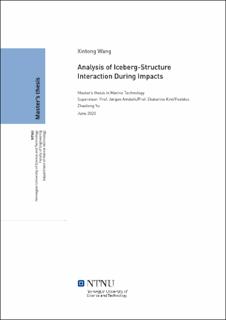| dc.description.abstract | With the increase of the maritime production and transportation in the arctic area, more offshore structures and ships are designed and built for operation in the ice infested water. The potential impact with the ice features is focused to maintain the structural integrity for design purpose. In this thesis, the interaction between the iceberg and the structure during the impact are analyzed to increase the understanding of the ice load on the structure and the response. The thesis mainly includes the literature review of related topics, the analysis of the design ice load in the rules, the modification of a numerical ice material model and the simulation of the slide impact between the iceberg and ship structure.
Through the review of the existed ice class rules and ice mechanics theories, the knowledge of the design ice load determination and ice material properties during the impact is developed to generate theoretical basis for analysis and discussion.
A new design ice load model is derived based on the first principles of the ice mechanic. With the same impact scenario and the hull geometry, the new design ice load from the ice mechanics model is lower than the rules. Form the point view of the ice, such large loads on the structure as the rules suggest are too conservative, especially for the high polar classes such PC1 and PC2. The ship speed is considered continuously through the strain rate effect in the new model, while a discrete consideration of polar class dependent speed is taken in the rules due to lack of operating experience. The increasing trend of the design ice load with the ship displacement in the rules is not obvious in the ice mechanics model, which is believed also out of conservative consideration. Some topics are summarized into a prepared paper.
To apply the integrated analysis with both explicitly modelled objects, a consistent constitutive material model for the iceberg ice is modified based on a developed model. A damage stage is introduced to improve the erosion procedure of failing elements. The stress degradation is implemented by damage variables, a damage evolution law and a final failure criterion, which are developed based on the continuum material mechanics. With the damage stage, more plastic deformation is allowed before erosion for the ice material, so the non-contact space between the iceberg and the structure is eliminated. The oscillation of the force during the application of the original material model can be reduced effectively.
The improper behavior of the original model during the unloading is improved by adjusting Bulk Viscosity in the ABAQUS. The uniaxial loading, uniaxial loading-unloading and rigid wall crushing simulations are applied to verify the behavior of the modified material model. Acceptable results are generated and mesh-insensitivity is proved in the verification simulations. Through the calibration, the parameters in the material model are adjusted to generate the same crushing force curve as the PC1 in the rules.
With the modified material model, the nonlinear simulations of the impact between the iceberg and a ship side structure are applied in the ABAQUS. Both the predefined path impact and the more realistic impact with the rigid body motion are simulated. Critical impact cases are applied in the simulations, resulting in substantial energy dissipation. The influence to the interaction process from the impact parameters are obvious and revealed simply through the parametric study.
Based on an analytical impact model, the equivalent friction factor could be used to estimate the the tangential contact force from the normal contact force during the slide impact. From the simulation results, a value between 0.5 to 1 is suggested for the slide impact between the iceberg and stiffened panel used in the marine structure widely. The factor is found rather sensitive to the material properties, involved hydro-forces and impact parameters. For simplicity, it could be determined based on the lateral penetration because the factor partly depends on the deformation and damage. The more deformation or damage is generated in the structure and the iceberg, the larger is the equivalent friction factor. Thus, the influence of the other conditions could be reflected by a larger or smaller penetration distance in general.
Due to the time and personal capacity limit, there are still defects in the thesis. It is found that the derived new design ice load model is sensitive to the impact geometry, which is not discussed in detail. Several theoretical assumptions are made in the development of the damage stage for the ice material model, which will be improved if an analytical material model for the damage ice could be referred. Thus, the recommendations for the further work are addressed. | |
